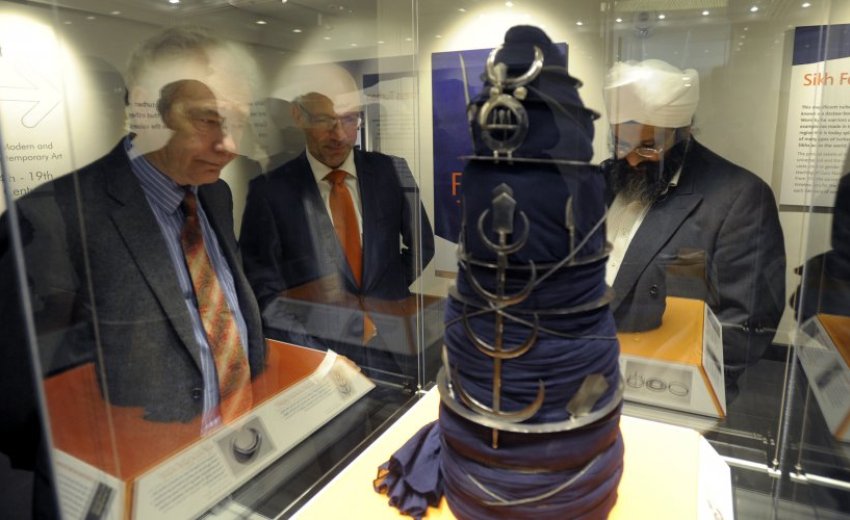The British Library, located in the UK, houses captivating collections, including a little-known yet immensely significant Sikh artefact called the "Nihang/Akali" turban. This turban made of blue cloth is adorned with steel blades and quoits. It is displayed on a wooden cone. One of the steel weapons bears the insignia of 'Rattray's 45th,' a Sikh police battalion founded in the 1850s.
Turban: The Sikh pride
Historian and author Parmjit Singh explains that the turban mentioned is known as a "Naina Singhia dhirmukhia dastaar bunga," with "dastaar bunga" referring to the tall fortress turbans worn by Nihang Sikhs. The term "dhirmukhia" indicates the presence of an "arrow-headed" quoit with attached swords and daggers. This particular feature sets it apart, as neither the V&A nor the Royal Armouries turbans possess it.
Another notable emblem, of smaller size, is associated with the Sikh police battalion called ‘Rattray's 45th’, which was established in the 1850s. The metalwork prominently features the repeated image of a double-edged sword blade, an essential symbol in Sikhism known as a "khanda." The central ornament, known as a “gajgah", is fairly typical but less commonly found. The steel wire, which securely holds the elements of the turban in place, is a customary and essential component. However, the quality of the metalwork in this turban is not as refined as the one displayed in the V&A, which has gilding.
The turban has a special meaning for Sikhs. It represents their dedication to their faith and helps protect their uncut hair. The Dastar Boonga,was a specific type of turban worn by the Sikh warriors, which had a tall conical shape like a fortress. It was tied by intertwining the long hair with the turban cloth, which could be very long. They also attached ornaments like steel quoits and small daggers to the turban for extra protection. The Sikh warriors, known as Akali-Nihangs, were raised to defend Sikhism against the Mughal Empire's persecution. They wore dark blue clothes, iron bangles, and steel quoits in their turbans. Today, the Akali-Nihangs continue to uphold these traditions in Punjab.
Display turbans
In the past, people used "display" turbans like this to showcase the intricate metalwork. These turbans were highly valued, and collectors and enthusiasts would proudly exhibit the ornamental pieces worn by famous warriors. Similar display turbans can be found in notable Sikh temples in India, as well as being referenced in the 19th century European exhibitions.
The cloth of this particular turban is in a very fragile state, easily crumbling into powder when handled. However, the metalwork remains intact and only requires cleaning. M Pullan, a conservator, commented on the fabric's condition, stated that the most challenging aspect is determining the arrangement of the fabric at the top of the turban is, whether it has a 'farla' or not. According to him both options are correct, but apparently, if there is a 'top knot,' it signifies the rank of 'Akali Nihang.' If not, it is simply 'Nihang' and should not be referred to as Akali. He said that as he will explore the remaining 'chaos' of fabric more, the original structure will become clear."
The Akali turban has been part of the BM collection for several years, possibly dating back to the 19th century. It belongs to the Asian Department's collection of arms and armor, which was moved from its previous location in the early 1980s.
*Based on an article by Amandeep Madra, published on 25th July 2008
